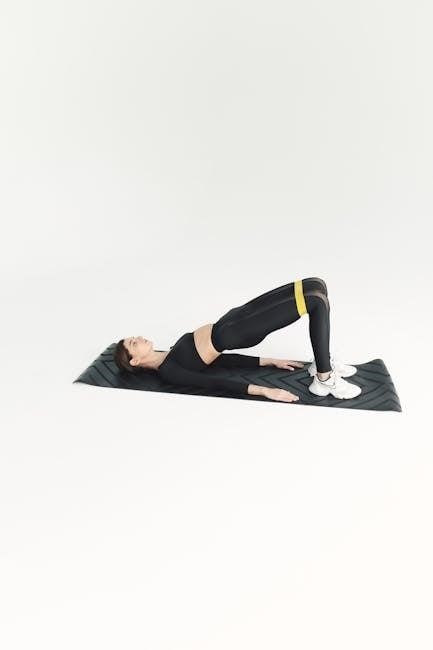
Resistance band workouts offer a versatile‚ cost-effective way to strengthen muscles anywhere. Portable and easy to use‚ they provide full-body exercises for all fitness levels‚ with downloadable PDF guides available.

Benefits
Resistance bands offer portability‚ cost-effectiveness‚ and space efficiency‚ making them ideal for home workouts. They provide versatile exercises for full-body strength training and are suitable for all fitness levels.
Portability
Resistance bands are lightweight and compact‚ making them easy to carry in a bag or suitcase. Their small size allows for workouts anywhere‚ whether at home‚ in a hotel‚ or outdoors. This portability is ideal for travelers or those with limited space‚ ensuring you can maintain your fitness routine without relying on bulky gym equipment. Their convenience makes them a popular choice for people seeking flexible and accessible workout solutions.
Cost-Effectiveness
Resistance bands are an affordable fitness option‚ offering a budget-friendly alternative to expensive gym memberships or heavy equipment. They are durable and long-lasting when used properly‚ providing great value for their low cost. With a variety of resistance levels available‚ they cater to all fitness goals without breaking the bank. This affordability makes them an excellent choice for anyone looking to invest in a cost-effective workout solution that delivers results.
Space Efficiency
Resistance bands are highly space-efficient‚ making them ideal for home workouts‚ travel‚ or small spaces. They are lightweight‚ compact‚ and easy to store‚ requiring minimal storage space. Perfect for apartments‚ hotels‚ or anywhere with limited room. No bulky equipment is needed‚ allowing you to train effectively without sacrificing space. This convenience makes them a great option for those who want to stay fit without the need for a large workout area.
Versatility
Resistance bands are incredibly versatile‚ offering a wide range of exercises for every muscle group. They can be used for strength training‚ stretching‚ and rehabilitation‚ making them suitable for both beginners and advanced users. With various resistance levels and the ability to combine bands‚ you can customize workouts to meet your fitness goals. Whether targeting the upper body‚ lower body‚ or core‚ resistance bands provide endless exercise options‚ ensuring a well-rounded and effective workout routine.

Types
Resistance bands come in various forms‚ including loop bands‚ tube bands‚ and figure-8 bands‚ each designed for specific exercises and fitness goals.
Loop Bands
Loop bands are circular resistance bands ideal for full-body workouts. They come in varying resistance levels‚ making them suitable for both beginners and advanced users. Their design allows for exercises like squats‚ lunges‚ and shoulder presses. Loop bands are lightweight and portable‚ perfect for home or travel use. They are versatile‚ enabling effective training of the upper body‚ lower body‚ and core. Their simplicity and durability make them a popular choice for strength training and rehabilitation exercises.
Tube Bands
Tube bands are durable resistance bands with handles‚ offering versatility in strength training. They come in varying lengths and resistance levels‚ suitable for both upper and lower body exercises. Tube bands are ideal for workouts like chest presses‚ rows‚ and shoulder presses. Their ergonomic handles provide comfort during exercises‚ making them a popular choice for home and gym use. Tube bands are easy to anchor‚ allowing for a wide range of exercises that target multiple muscle groups effectively. They are a great tool for progressive resistance training.
Figure-8 Bands
Figure-8 bands‚ also known as cross bands‚ are lightweight and compact‚ with a unique shape that allows for dynamic exercises. They are ideal for targeting multiple muscle groups‚ such as the chest‚ shoulders‚ and legs. Their design enables full-range movements‚ engaging both the concentric and eccentric phases of an exercise. Figure-8 bands are perfect for exercises like bicep curls‚ chest presses‚ and lateral walks. They are easy to carry and offer a great way to add variety to any resistance band workout routine.

Best Exercises
Resistance bands are effective for full-body workouts‚ targeting muscles like chest‚ shoulders‚ and legs. Popular exercises include chest presses‚ rows‚ and bicep curls‚ promoting strength and flexibility.
Upper Body
Resistance bands are highly effective for targeting the upper body‚ including chest‚ shoulders‚ and arms. Exercises like chest presses‚ shoulder presses‚ and rows can be performed with or without anchors‚ providing a full range of motion. Bicep curls and tricep extensions are also popular for isolating arm muscles. These exercises improve strength‚ flexibility‚ and overall muscle tone‚ making them ideal for both beginners and advanced users. They offer a versatile workout without the need for heavy equipment.
Lower Body
Resistance bands are excellent for strengthening the lower body‚ including legs‚ hips‚ and glutes. Exercises like squats‚ lunges‚ and leg curls target multiple muscle groups simultaneously. The bands provide continuous tension‚ enhancing muscle engagement and improving flexibility; For example‚ placing a band around the knees during side steps or using it for hip thrusts effectively works the glutes. These exercises are ideal for building strength‚ improving balance‚ and sculpting the lower body without heavy equipment‚ making them perfect for home workouts.
Core
Resistance bands are ideal for strengthening the core‚ including abs‚ obliques‚ and lower back muscles. Exercises like banded crunches‚ Russian twists‚ and leg raises effectively target these areas. The bands provide continuous tension‚ enhancing muscle engagement and improving stability. They also allow for dynamic movements that challenge the core from multiple angles. Incorporating resistance bands into your core routine can improve posture‚ balance‚ and overall athletic performance‚ making them a versatile tool for home or gym workouts.
Full Body
Resistance bands are excellent for full-body workouts‚ engaging multiple muscle groups simultaneously. Exercises like banded squats‚ chest presses‚ and rows target the legs‚ chest‚ and back. The bands provide consistent tension throughout movements‚ enhancing strength and endurance. For a comprehensive routine‚ combine upper and lower body exercises‚ such as overhead presses and lunges‚ to work the shoulders‚ arms‚ and legs. This approach maximizes efficiency‚ making resistance bands a perfect tool for a total-body transformation. Use varying resistance levels to progress your workout.

Full Body Workout
Resistance bands offer efficient full-body workouts‚ targeting major muscle groups with minimal equipment. They enhance strength‚ flexibility‚ and endurance‚ making them ideal for home or travel routines.
Warm-Up
A proper warm-up is essential before starting any resistance band workout. Begin with 5-10 minutes of light cardio‚ such as jogging in place or jumping jacks‚ to increase blood flow. Dynamic stretching‚ like arm circles and leg swings‚ helps prepare muscles for movement. Loop the band under your feet and perform gentle rows or presses to activate major muscle groups. Finish with deep breathing exercises to ensure proper oxygen flow. This routine ensures your body is ready for the workout ahead and reduces injury risk.
Exercise Circuit
An effective resistance band exercise circuit combines strength and endurance. Start with chest presses (3 sets of 12 reps) and bent-over rows (3 sets of 10 reps) to target the upper body. Follow with squats (3 sets of 12 reps) and lateral band walks (2 sets of 15 reps) for the lower body. Include overhead presses (3 sets of 10 reps) and bicep curls (2 sets of 15 reps) to engage the shoulders and arms. Rest for 30 seconds between sets and 60 seconds between circuits. This circuit builds muscle‚ improves cardiovascular fitness‚ and enhances overall mobility.
Cool-Down
A proper cool-down after your resistance band workout is essential to relax muscles and improve flexibility. Begin with static stretches for hamstrings‚ chest‚ and shoulders‚ holding each for 20-30 seconds. Use the resistance band to gently stretch tighter areas‚ such as the hips and calves. Incorporate deep breathing exercises to reduce stress and promote relaxation. This routine helps prevent muscle soreness‚ enhances recovery‚ and leaves you feeling refreshed and rejuvenated after your workout.

Workout Plan
A well-structured workout plan with resistance bands helps achieve fitness goals. Create a schedule with specific exercises‚ sets‚ and reps‚ progressing weekly. A sample 4-week program targets different muscle groups‚ ensuring balanced growth and strength. Stick to the plan consistently for optimal results.
Creating a Plan
Creating a resistance band workout plan involves setting clear goals and selecting exercises that target specific muscle groups. Start by assessing your fitness level to choose appropriate resistances. Divide your routine into upper body‚ lower body‚ and core workouts. Include warm-ups and cool-downs for safety. Schedule 3-4 sessions per week‚ allowing rest days for recovery. Track progress by increasing resistance or reps over time. Downloadable PDF guides offer structured templates to customize your plan effectively.
Sample 4-Week Plan
A sample 4-week resistance band workout plan is designed to progressively build strength and endurance. Week 1 focuses on foundational exercises like banded squats‚ chest presses‚ and rows. Week 2 introduces more dynamic movements‚ such as banded lunges and shoulder presses. Week 3 incorporates full-body circuits for efficiency. Week 4 increases intensity with higher resistance and compound exercises. Each session includes a 5-minute warm-up and cool-down. Downloadable PDF guides provide detailed rep schemes and exercise variations for each phase‚ ensuring a balanced and structured approach to fitness.

Tips
Start with light resistance to build strength gradually. Focus on proper form to avoid injury. Maintain consistent breathing and pace during exercises. Stay committed for visible results.
Starting with Light Resistance
Begin with lighter resistance bands to build strength gradually. This approach reduces injury risk and allows proper form. Start with lower resistance levels (e.g.‚ 15-25 lbs.) for upper body and core exercises. As you progress‚ switch to higher resistance bands. Focus on controlled movements and avoid overstretching. Gradually increasing resistance ensures steady muscle growth and prevents plateaus. This method is ideal for beginners and helps develop foundational strength effectively.
Focus on Form
Maintaining proper form is essential for effective and safe resistance band workouts. Keep your spine neutral‚ engage your core‚ and avoid rounding your shoulders. Ensure the band is anchored securely and adjust your stance as needed. Focus on slow‚ controlled movements to prevent injuries and maximize results. Proper form ensures you target the correct muscles and avoid unnecessary strain. Prioritizing form enhances workout efficiency and reduces injury risks‚ making your exercises more productive and sustainable.
Breathing Techniques
Proper breathing is crucial during resistance band workouts to maintain stability and prevent injury. Exhale during the exertion phase (when pulling or pushing the band) to engage your core and maintain control. Inhale during the return phase (when releasing tension) to relax and reset. Avoid holding your breath‚ as this can increase pressure and reduce performance. Steady breathing enhances endurance‚ focus‚ and overall exercise efficiency. Syncing breath with movement ensures a safer and more effective workout experience for all fitness levels.
Consistency
Consistency is key to achieving results with resistance band workouts. Regular practice‚ even a few times a week‚ helps build strength and muscle endurance. Aim for systematic training to ensure progress and overall fitness improvement. Create a routine that fits your schedule‚ ensuring workouts are frequent and structured. Over time‚ consistent effort will yield noticeable gains in strength‚ flexibility‚ and muscle tone. Stick to your plan and embrace the journey for long-term success.

Safety
Inspect resistance bands for damage before use and ensure proper anchoring to prevent snapping. Always check for wear and tear to avoid injuries during workouts.
Proper Anchoring
Securely anchor resistance bands to a stable object‚ like a door or column‚ to maintain control and prevent snapping. Use a towel or fabric to wedge the band firmly in place‚ ensuring the door is closed tightly. This setup provides a safe and effective way to perform exercises without risking injury from band slippage or breakage during your workout routine.
Inspecting Bands
Always inspect resistance bands for cracks‚ frays‚ or signs of wear before use. Damaged bands can snap during exercises‚ causing injury. Store bands in a cool‚ dry place to prevent deterioration. Replace bands if they show significant wear or lose their elasticity. Regular inspection ensures safety and effectiveness during workouts‚ helping you achieve your fitness goals without unnecessary risks.

Progression
Gradually increase resistance by using thicker bands or combining multiple bands. Introduce advanced exercises and vary routines to challenge muscles and avoid plateaus effectively.
Increasing Resistance
To progressively challenge your muscles‚ start by using bands with higher resistance levels or combine multiple bands for added tension. This method allows you to gradually increase the intensity of your workouts without needing expensive equipment. As you build strength‚ incorporating advanced exercises and varying your routines will help prevent plateaus and ensure continuous progress in your fitness journey. Consistency and proper form are key to achieving desired results safely and effectively.
Exercise Variation
Varying your exercises is crucial for a well-rounded workout. Use different types of bands‚ such as loop‚ tube‚ or figure-8 bands‚ to target various muscle groups. Experiment with alternating reps‚ sets‚ and angles to keep your routine fresh. Incorporate dynamic movements‚ like lateral walks or rotational exercises‚ to engage your core and improve mobility. By mixing up your exercises‚ you can avoid plateaus and ensure continuous progress in strength and flexibility. This approach keeps your workouts engaging and effective.
Resistance band workouts are a practical and effective way to build strength‚ improve flexibility‚ and enhance overall fitness. With their portability and versatility‚ these bands allow you to create dynamic routines anywhere. By incorporating various exercises and following structured plans‚ you can achieve measurable results. Whether you’re a beginner or an advanced user‚ resistance bands offer a sustainable path to wellness. Embrace their convenience and diversity to maintain a consistent and rewarding fitness journey.

Additional Resources
Downloadable PDF guides and online resources provide comprehensive workout plans and exercise tutorials for effective resistance band training‚ helping you maximize your fitness journey.
Downloadable PDFs
Free printable resistance band workout guides are widely available online. These PDFs offer detailed exercise charts‚ 4- to 12-week training programs‚ and step-by-step instructions for all fitness levels. They include plans for strength building‚ mobility‚ and full-body workouts‚ making it easy to create a structured routine. Many resources also provide progression tips and nutrition advice to enhance results. Download these guides to start your resistance band journey anytime‚ anywhere.
Online Guides
Online guides provide comprehensive resistance band workout plans‚ often professionally designed and user-friendly. Websites like The Fitness Phantom and MSU Extension offer free downloadable resources‚ including 4- to 12-week programs. These guides feature detailed exercises‚ rep schemes‚ and progression tips. Many include video tutorials and nutrition advice to enhance results. They cater to all fitness levels‚ from beginners to advanced users‚ making it easy to follow structured routines and track progress effectively.
Resistance band workouts are a versatile and effective way to build strength‚ improve mobility‚ and enhance overall fitness. These portable tools allow you to exercise anywhere‚ making them ideal for home workouts or on-the-go training. With a variety of resistance levels and exercises‚ they cater to all fitness levels‚ from beginners to advanced users. Downloadable PDF guides provide structured programs‚ including 4-week plans‚ exercise charts‚ and tips for proper form and progression. They offer a convenient and comprehensive approach to achieving your fitness goals.
Resistance bands are portable‚ cost-effective‚ and space-efficient‚ offering versatile workouts for all fitness levels. They provide continuous tension‚ enhancing strength and mobility while being easy to use anywhere‚ anytime.
Resistance bands are lightweight and compact‚ making them easy to carry in a gym bag or suitcase. Their small size allows for storage in limited spaces‚ ideal for home workouts or travel. Portability ensures you can exercise anywhere‚ maintaining your fitness routine without interruption. Whether at home‚ in a hotel‚ or outdoors‚ resistance bands are the perfect companion for staying active on the go.
Cost-Effective
Resistance bands are an economical and budget-friendly option for strength training. They are often sold in sets with varying resistance levels‚ making them accessible to everyone. Unlike heavy gym equipment‚ bands are affordable and require minimal investment. Additionally‚ free downloadable PDF guides provide workout plans‚ making it easy to start without extra costs. This affordability‚ combined with their versatility‚ makes resistance bands a practical choice for fitness enthusiasts of all levels.